







Since 2000, Wexler Gallery has built a reputation for curating and presenting exceptional work at the intersection of fine art, collectible design, and craft. With locations in New York City and a flagship 11,500-square-foot space in Philadelphia’s Fishtown neighborhood, the gallery represents a diverse roster of established and emerging artists whose practices span disciplines and challenge traditional boundaries.
Our program brings together important vintage design, contemporary fine art, and bespoke design objects, offering a unique resource for collectors, institutions, and design professionals alike. Many of our artists are featured in major museum and institutional collections, and we regularly facilitate private, public, and hospitality commissions on both national and international scales.
We are proud to partner with architects, interior designers, and art advisors to source exceptional work that resonates—whether for residential projects, hospitality spaces, or curated collections. From rare historical pieces to site-specific commissions, Wexler Gallery offers access to a dynamic and evolving canon of artists shaping the future of art and design.

WEXLER GALLERY / PHILADELPHIA
1811 FRANKFORD AVENUE
PHILADELPHIA, PA 19125
215-923-7030
GALLERY / NEW YORK
200 LEXINGTON AVENUE, SUITE 431
NEW YORK, NY 10016
Meerschaum, blown glass, brass, LED, 96 x 12 x 12 inches
Berlin, DE
Henry Baumann’s acclaimed Boo series epitomizes his artistry, featuring tables and seating crafted from meticulously stacked resin bubbles. These organic forms, influenced by chance yet guided by his thoughtful frameworks, glow with a gentle translucency that imparts a sense of fluidity and elegance. Resting atop polished brass feet, the pieces invite touch with their smooth, matte surfaces, striking a harmonious balance between structure and spontaneity.
Eschewing initial sketches, he works intuitively, embracing the unexpected. “When I’m experimenting with these materials, I often begin with an idea that fails—but through failure, something unexpected emerges. I’m fascinated by that process,” he shares.
His extensive exhibition history spans Vienna, Düsseldorf, Milan, Amsterdam, and beyond, with pieces featured in museum collections such as Kunstfestival Watou in Belgium and Kunstkraftwerk Leipzig.

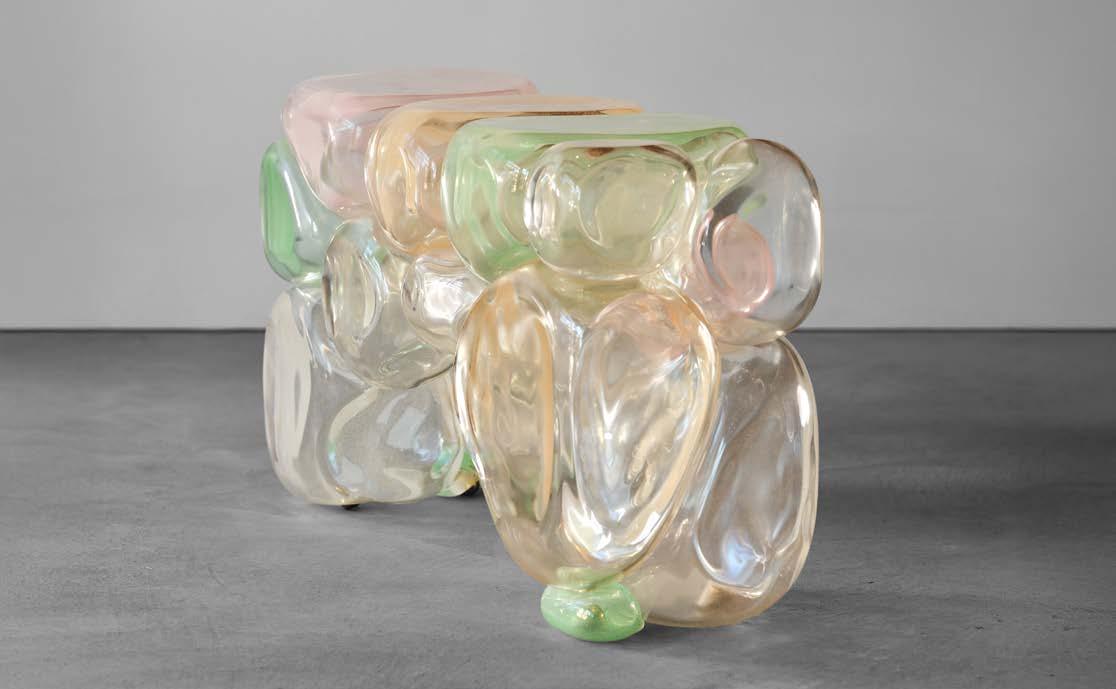
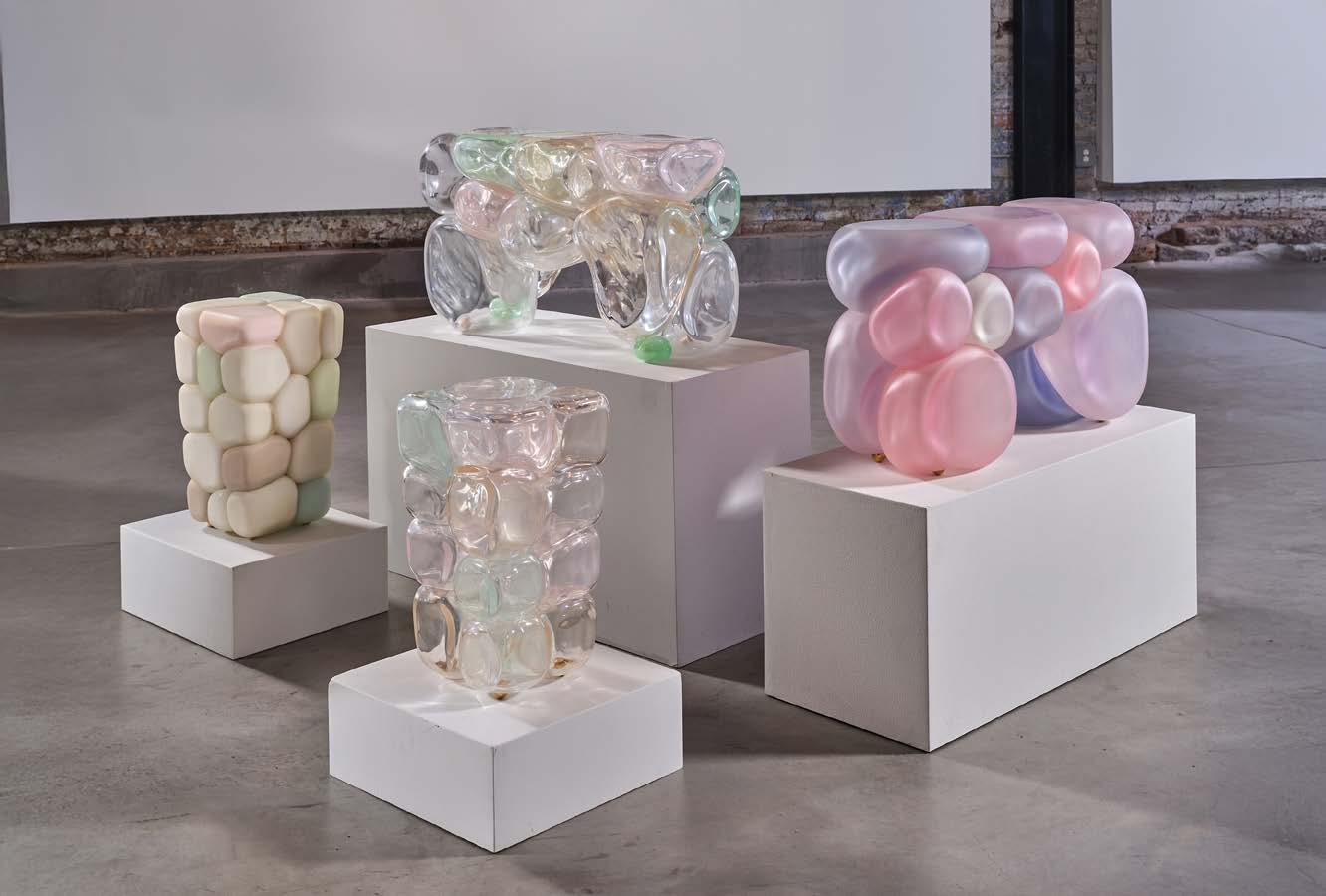
(clockwise from top)
Excessive Boo: Glacé, 2025
Resin, 19 x 32.5w x 11.75 inches
Excessive Boo, 2024
Resin, 19 x 32.5w x 11.75 inches
Trophy Glacé, 2025
Resin, 19 x 11.75 x 11.75 inches
Trophy (Mother of Pearl), 2023
Resin, 19 x 11.75 x 11.75 inches
Pennsylvania, USA
Cimone Kind Berman plays with light, reflection and transparency, creating works that are a fusion of time-honored craftsmanship and transformative alchemy. Each mirror tells a unique story, blending history, craft, and artistic vision, inviting observers to glimpse both their own reflection and the enchanting metamorphosis of existence itself.
By infusing the essence of alchemy into her work, Berman transmutes clear glass into ethereal portals. These mirrors become vessels where copper, silver, and gold meld together, embodying the intrinsic beauty of the elements.
Please inquire about custom creations in color, reflectivity and scale.
She Watches, 2024
Glass, tin, silver, epoxy, steel, 47 inches diameter



New York, USA
Marcus Vinicius De Paula is a Brazilian-American sculptor based in New York whose practice explores identity, ancestry, and humanity’s place within the cosmos. The son of Brazilian immigrants—his father having risen from a small town in São Paulo to directing NASA Mars missions—De Paula reflects on legacy and fragility through stone and light. His sculptures, often titled after moons of Saturn, blend volcanic rock, granite, and alabaster—some over a billion years old—with neon and LED illumination, producing works that read as relics from another world. By handcrafting both stone forms and glass light elements, he creates monumental objects that fuse the ancient and futuristic, evoking both interstellar matter and human aspiration.
Informed by Brutalist and Modernist architecture in Brazil, as well as memories of traversing Rio de Janeiro’s visual landscape, De Paula considers his works as maquettes with unlimited potential scale. His multidisciplinary background in theater, film, and live performance—designing with light for over 15 years—further shapes his sculptural vision. He has led creative direction for installations at South by Southwest, on tour with Ra Ra Riot, and at the Edinburgh Fringe, and his sculptures have been exhibited at the Salon Art & Design Fair (2024), Burning Man (2022), Davidson Gallery (2022), Verso (2023), and Love House (2025).
Ceres, 2020
Utah black lava rock (Scoria), resin, LEDs, 15 x 22 x 5 inches

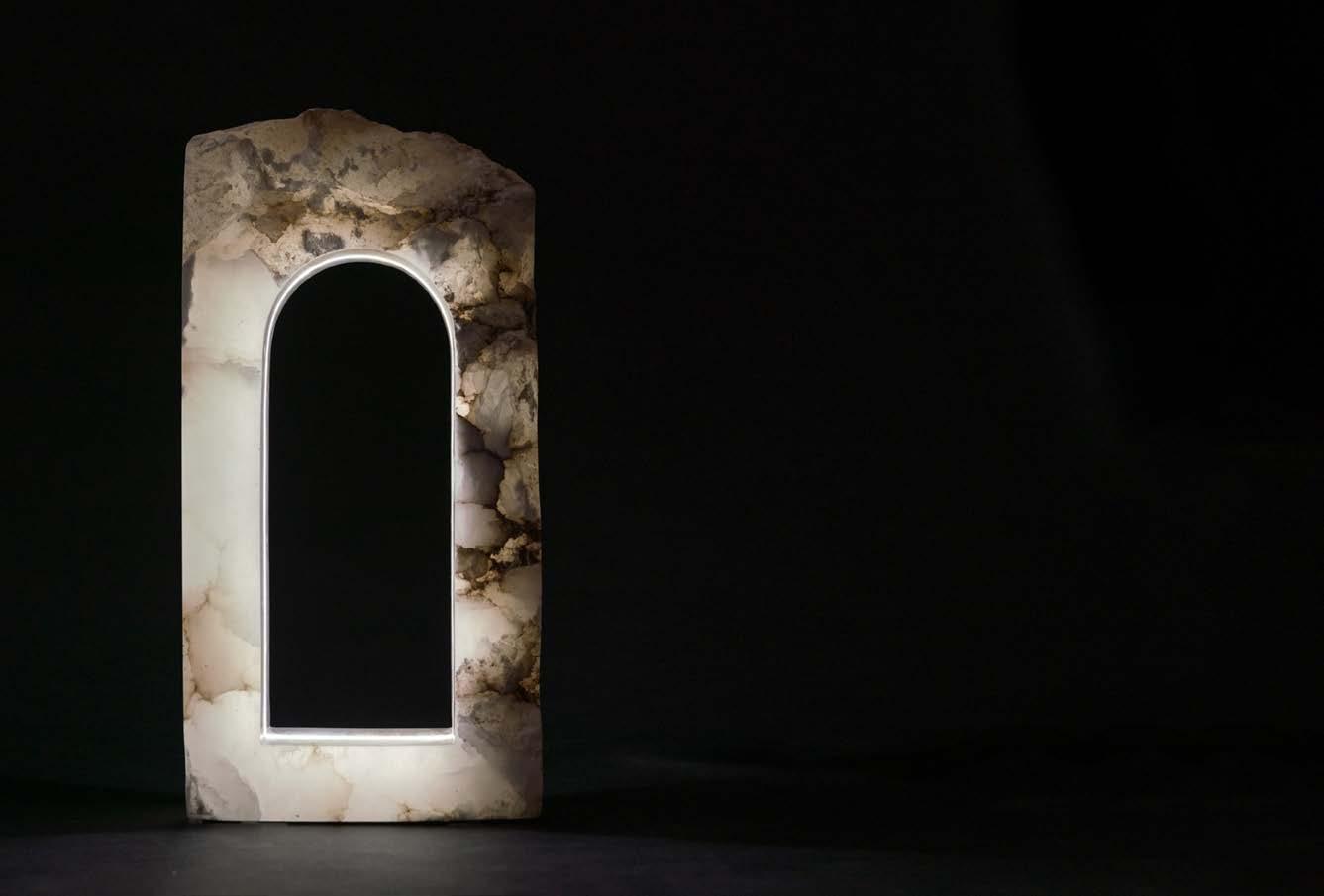
Erebus, 2024
Italian Alabaster, LED, Acrylic, 20 x 10 x 4 inches


New York, USA
Richard Haining is an artist and studio furniture maker whose practice bridges sustainable design and fine craft. Raised in Atlanta, GA, and educated at the Rhode Island School of Design, he has lived and worked in Brooklyn since 2008. Guided from an early age by the belief that if something could be made better, you should learn to make it yourself, Haining brings this ethos to his work, honoring both process and material integrity. Drawing inspiration from discarded wood across New York City—from shop offcuts to old-growth timbers salvaged from pre-war buildings—he meticulously hand-stacks thousands of wood segments to form his celebrated STACKED Collection. Similar to coiled ceramics or analog 3D printing, his process creates unique forms that are refined by hand to reveal surfaces rich with variation and history. His work, which embodies permanence in an age of disposability, has been exhibited worldwide, collected internationally, and recognized with awards such as the James Renwick Alliance Award of Excellence for Innovation in Craft and the RISD People’s Choice Award.
Stacked 10-Bulb Chandelier, 2025
Salvaged California Redwood, LEDs, 16 x 36 x 36 inches
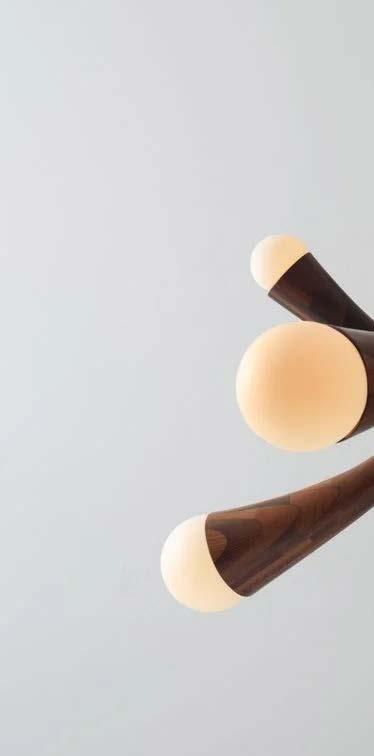


Salvaged ash with an ebonized finish, 33 x 7 x 15.75 inches


Thirroul, AU

Trent Jansen, a designer based in Thirroul, Australia, is a Lecturer at the University of New South Wales Art & Design. He earned his PhD from the University of Wollongong under art historian Ian McLean and holds a Bachelor of Design from UNSW. Jansen studied in Canada at the University of Alberta and later worked under Marcel Wanders in Amsterdam before establishing his studio in Sydney, later relocating to Thirroul.
Jansen’s design practice is rooted in Design Anthropology, a research-driven approach that explores cultural narratives, identity, and history through objects. His work blends storytelling with material innovation, often incorporating local and indigenous influences. He is known for creating thought-provoking, limited-edition and one-off pieces that challenge conventional design language. A co-founder of Broached Commissions, Jansen’s work interrogates Australian identity and design heritage, earning praise from Marcel Wanders, who likens his impact to Droog’s role in shaping Dutch design.
Ngumu Janka Warnti (All Made from Rubbish) Chair, 2024
Aluminum fencing and saddle leather, 31.5 x 25.5 x 29.5 inches
Worcestershire, UK
Sofia Karakatsanis is fascinated by wood in all its forms; as a tree, a material, a fuel. As wood was once living it reacts to processes it is put through, moving and twisting. She responds to this in real time while constructing and carving, allowing a dialogue between maker and material. She grew up in the Black Country, a hub of industry in the UK. This lifelong exposure to craft fostered a strong fascination with making that has led to her own practice in wood, the material she feels most drawn to.
Sofia’s carving process is very organic, working with power carving tools such as angle grinders, down to finer hand tools, referencing sketches throughout. This allows her to create the forms intuitively, and react to the wood as it reacts to the processes and allow the grain to inform the shape. Sofia subjects her work to extreme conditions when finishing; chemical bleaching Sycamore to achieve a bone white color, and scorching Ash to create a blackened, highly textured finish. Working in this way allows the forms to be material led. As she carves, Sofia exposes and focuses on the natural grain in the wood, using this to inform and accentuate the shape. She wants to evoke the feeling that these pieces were once living, appearing to come from one piece by allowing the grain to inform the shape.

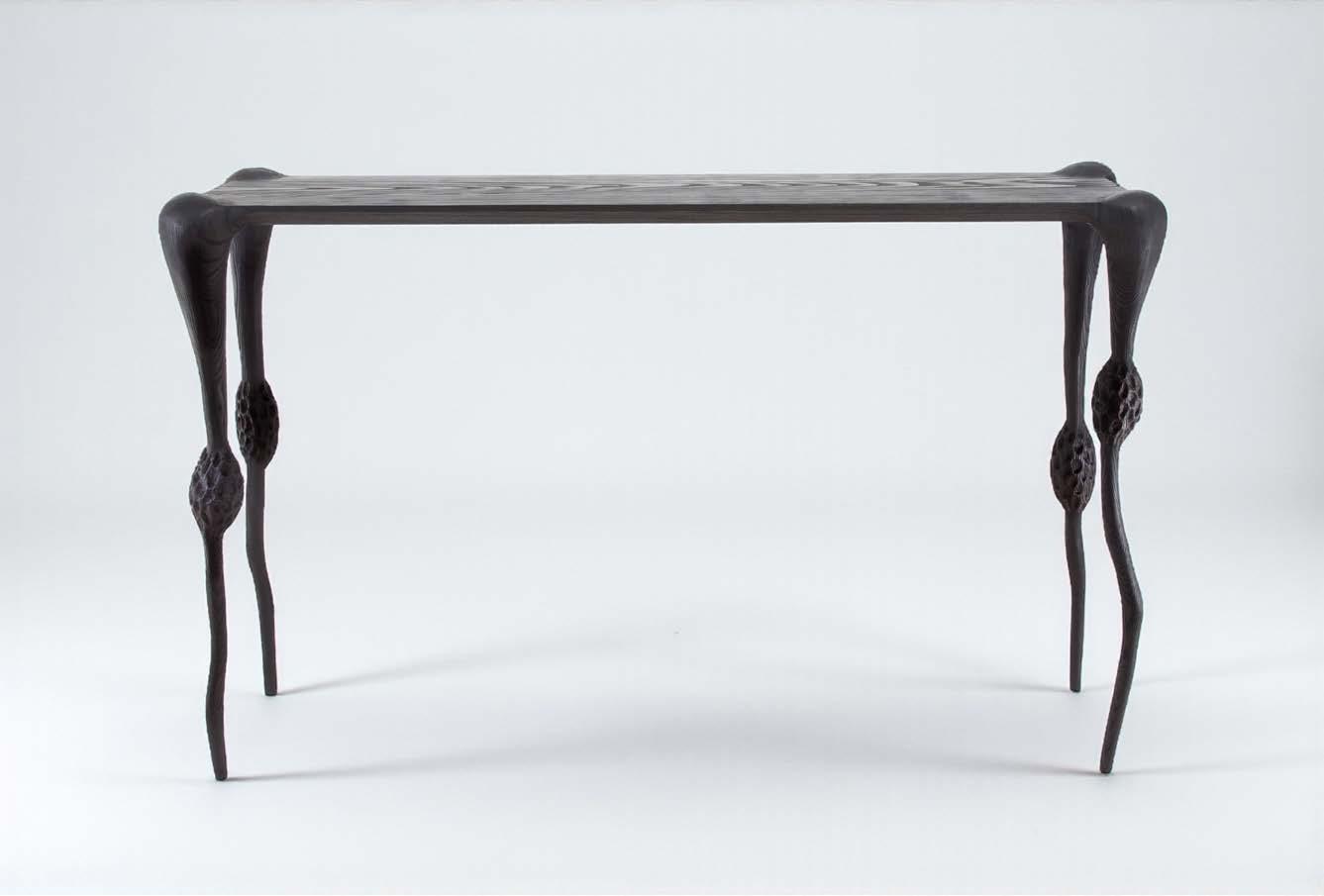

New York, USA
Inspired by the architecture and culture of her native Istanbul, Feyza Kemahlioglu has created a unique lighting collection entitled Pillars of Meerschaum. Meerschaum (German for “sea-foam”) is a soft white clay mineral found mainly in Eskisehir, a small city in central Turkey. Master Turkish craftsman carve the Meerschaum with intricate patterns and perforations to diffuse the light. The stone is then combined with hand-blown glass and brass elements created in New York. The blown glass compliments the detailing of the Meerschaum with the addition of delicate textures made with cane and gold leaf.
By taking this antiquated material and giving it a contemporary aesthetic and function, Feyza marries the old and the new to create timeless designs that are studies into the juxtaposition of tradition and modernity.
Pillars of Meerschaum Sconce, 2022
Meerschaum, blown glass, brass, LED, 60 x 6 x 6 inches



Pennsylvania, USA
Born in St. Louis, Missouri, in 1989, Nick Missel earned a BFA in Sculpture from the Kansas City Art Institute before completing an MFA at the Rhode Island School of Design as a Jack Kent Cooke Scholar. After graduating in 2016, he attended Skowhegan School of Painting and Sculpture, where he developed his ‘Negatives’ series—an ongoing exploration in his work.
Missel has exhibited at In Good Company (winning Best in Show), A/D/O, and Socrates Sculpture Park, NY. His practice, a form of “cultural archaeology of the working class,” focuses on overlooked objects, transforming them into new identities that exist in a liminal space between past, present, and future. Using silicone as a key material, he creates interactive, otherworldly sculptures that appear almost digital yet remain grounded in reality through the textures of their source objects. His work reflects an Anthropocentric worldview, where objects dissolve, shift, and reform, blurring the boundaries between memory and reinvention.
(top) Churn, 2025
Aluminum radiators, resin, 49 x 49 x 3.75 inches
(bottom) Letters After Midnight, 2024
Aluminum radiators, resin, fiberglass, 36 x 84 x 30 inches






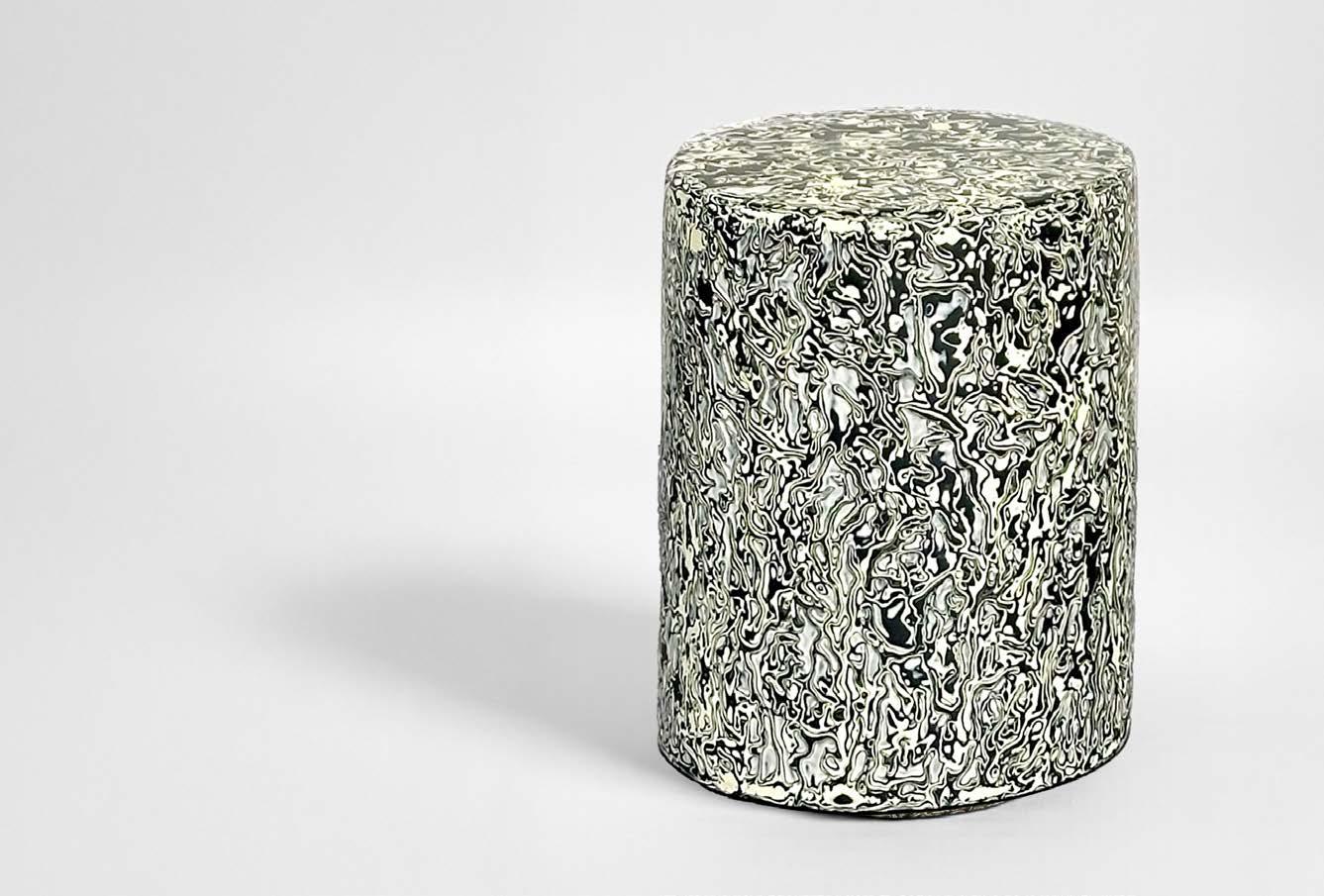
Flow Series: Stool, Black/White, 2025
Aluminum radiators, resin, 19.5 x 16 x 16 inches
Massachusetts, USA
Jonathan Prince, a New York–born artist based in the Berkshires, creates sculptural works that bridge science, technology, and spirituality. Initially trained as a maxillofacial surgeon, Prince returned to his lifelong passion for sculpture in 2002, establishing a world-class fabrication facility to pursue his artistic vision.
His practice centers on the dialogue between precision and imperfection—monumental forms that reveal both strength and vulnerability. Each work reflects his fascination with material transformation and the balance between chaos and beauty.
Now represented in collections worldwide, Prince continues to explore how form and matter embody the deeper tensions of existence, crafting sculptures that invite reflection on the complexities of the human condition.





Alchemy Series - Side Table, 2025
Corten steel cubes, glass, 21.5 x 18 x 18 inches




Bronze, 18.5 x 15 x 15 inches
Massachusetts, USA
Erin Sullivan makes functional sculpture encoded with the spirit of nature. She aims to honor nature’s intelligence and beauty while exemplifying its primal elegance. Each object amplifies the essence of the plant, animal, or element that inspired it. Together, her pieces construct a symbolic language which reconnects us to the mystery of the natural world.
Sullivan’s archetypal repertoire occupies the space between art and design. Themes of life and death, matter and spirit, masculine and feminine weave a mythopoetic narrative. With the art of ceremony at the center of her work, tables become altars, stools are totems, and mirrors can be portals. At a recent residency, Portal de Luz in Uruguay, Erin constructed a site-specific installation, “The Unified Field,” a nature temple of ritual space with natural and cast ceremonial objects.
Her process includes mold making, wax sculpting, and lostwax casting. Since 2014, her work has been exhibited and collected worldwide.
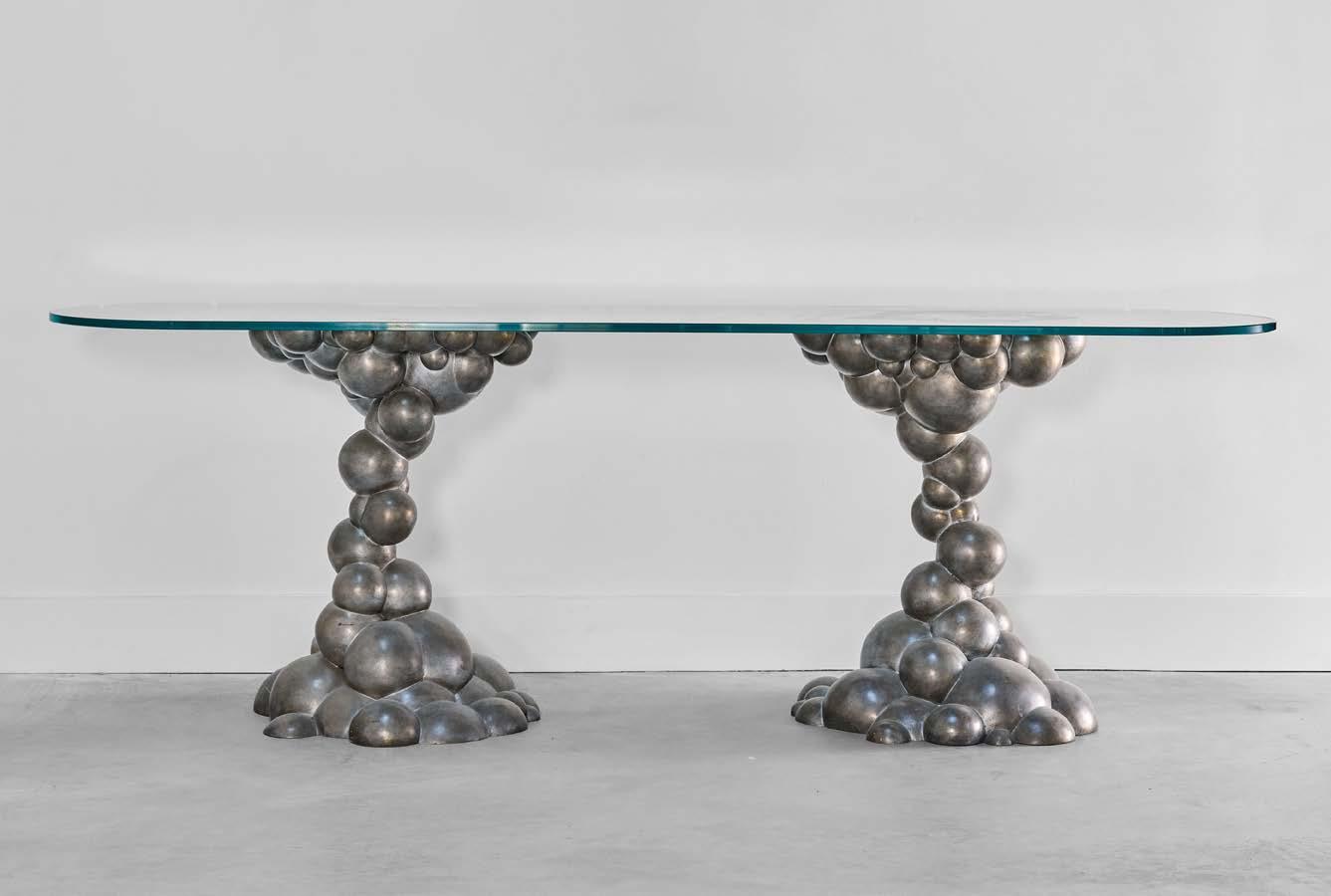

Virginia, USA
Ethiopian American artist and designer Jomo Tariku is a pioneer of modern African design. Visually striking, yet effortlessly functional, his work is rooted in Africa’s rich cultural heritage. A constant student of African art and culture, Jomo’s interest was sparked by the diverse art and created objects his family collected during their travels across Africa and beyond. His craft expresses a modern harmony of heritage, humanity, and design sensibility. Intended to be heirloom pieces to be celebrated and enjoyed for generations to come, Tariku’s spellbinding designs breathe warmth and vitality into living spaces.
The Meedo Chair is featured in The Metropolitan Museum of Art’s Afro-futuristic period room, Before Yesterday We Could Fly, and included in the Met’s permanent collection. Tariku’s work is also in the permanent collections of the Los Angeles County Museum of Art, the Mint Museum in Charlotte, NC, the Denver Art Museum, the Baltimore Museum of Art, the Carnegie Museum of Art, the Philadelphia Museum of Art and the Smithsonian’s National Museum of African American History and Culture. Several of Tariku’s designs are featured in the recent Marvel movie Black Panther: Wakanda Forever, whose Academy Award winning production designer Hannah Beachler was the curator for Before Yesterday We Could Fly. A champion of Black designers, Tariku helped co-found the Black Artists + Designers Guild (BADG) and is the recipient of the 2022 BADG Maker Award.



